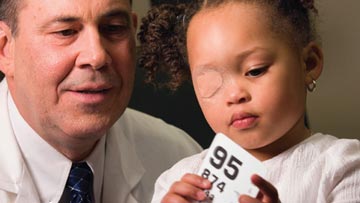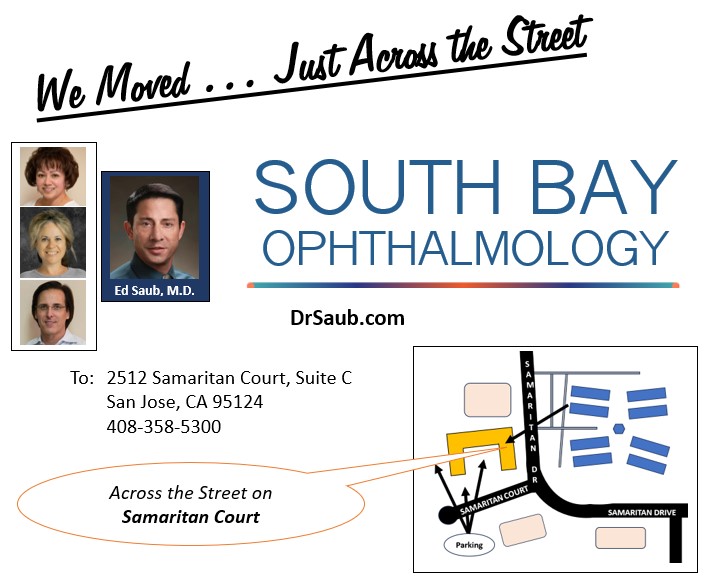Amblyopia
Amblyopia (“lazy eye”) is caused by unequal refractive errors, misaligned eyes (strabismus) or other abnormalities.
Patching is one technique for treating amblyopia. A patch is placed over the better-seeing eye to make the child use and develop good vision in the amblyopic (lazy) eye.

Child with patched eye
Atropine eyedrops or ointment is another technique for treating amblyopia. The medication is placed in the better-seeing eye on a regular basis. Atropine works by blurring the vision in the better eye, forcing the child to use and develop good vision in the lazy eye. Your ophthalmologist (Eye M.D.) should instruct you on the proper use and frequency of the atropine.
When should treatment begin?
Treatment of amblyopia should begin as early as possible. If your child is old enough to understand, explain the reason for using the patch or atropine. It may be helpful to demonstrate patching on a doll.
If your child attends school or preschool, explain the amblyopia treatment to the teacher. Enlist the teacher’s help to encourage your child to perform his or her usual tasks, while also making allowances for added difficulty from the treatment. The teacher can also help explain your child’s situation to classmates.
How long will the treatment take?
Treatment time will vary for different children. As a general rule, the younger the child is and the less amount of time the eye has been lazy, the shorter the length of treatment will be. In young children, vision may improve rapidly.
To ensure that a child is given the best possible chance to develop normal vision, the patching or atropine may be continued for a few weeks or months after vision stabilizes.
It is important that your child continue wearing the patch or using the atropine as instructed by your ophthalmologist. Fine, detailed work that holds the child’s interest will also encourage the use of the lazy eye and help speed visual recovery.
Once vision has improved in the lazy eye, there is a small chance that it can become worse again. Close observation of the eye is necessary throughout childhood.
It is important to note that patching or atropine improves vision in an amblyopic lazy eye, but does not help misaligned eyes. Once vision has improved, your ophthalmologist can recommend treatment for realigning the eyes.
If vision does not improve after a reasonable period, your ophthalmologist may recommend discontinuing treatment.
Are there any side effects from treatment?
Because the better-seeing eye is not used during treatment, occasionally vision in that eye may decrease, but it will usually return to normal as soon as that eye is used again.
The skin at and around a patched eye may become irritated. Trying a different type of patch or changing the shape of the patch may help relieve skin irritation. To prevent irritation, leave the patch off at night while the child is sleeping.
There is also an increased risk of accidents while the child is wearing a patch. To prevent accidents, the child should be monitored closely while wearing a patch and not engage in hazardous activities, such as bicycling, climbing gym sets, etc.
What kind of patch should be used?
The patch should be comfortable, remain firmly in place, and not allow the child to peek around the edges. Commercial patches are available at most drugstores or online and come in regular and juniors’ sizes. The patch should be attached directly to the skin around the eye for best results. A gauze pad held firmly in place with hypoallergenic tape, or a dark cloth cut in an oval shape, can also serve as an adequate homemade patch.
Black eye patches that are held on the child’s head with elastic or ties, such as a pirate-type patch, should not be used; they are too easy to remove or peek around. Patches that slip over eyeglasses are also available and can be an alternative for children already accustomed to patching. However, since these patches can slip and allow peeking, they are not a good choice for children who are just beginning treatment.
What if the child removes the patch?
For infants and toddlers, try applying extra tape over the patch to secure it. Thin, cellophane-type tape may make it more difficult to remove the patch. If your child is still able to remove the patch, try covering his or her hands with mittens or socks. Distraction is often helpful for younger children. Also, using a reward system is a very effective strategy to encourage the child to wear the patch.
When you first start treatment, it may be very difficult for both you and your child. With time, and with the advice and support of your ophthalmologist, treatment will usually be successful.
Amblyopia
Article Videos
- Anatomy of the Eye
- Botox
- Cataracts
- Diabetes and the Eye
- Diabetic Retinopathy – What is it and how is it detected?
- Treatment for Diabetic Retinopathy
- Non-Proliferative Diabetic Retinopathy (NPDR) – Video
- Proliferative Diabetic Retinopathy (PDR) – Video
- Cystoid Macular Edema
- Vitreous Hemorrhage – Bleeding from diabetes (Video)
- Vitrectomy Surgery for Vitreous Hemorrhage (Video)
- Macular Edema
- Laser Procedures for Macular Edema (Video)
- Laser for Proliferative Diabetic Retinopathy – PDR (Video)
- How the Eye Sees (Video)
- Dilating Eye Drops
- Dry Eyes and Tearing
- Eye Lid Problems
- A Word About Eyelid Problems
- Bells Palsy
- Blepharitis
- Blepharoptosis – Droopy Eyelids (Video)
- Dermatochalasis – excessive upper eyelid skin (Video)
- Ectropion – Sagging Lower Eyelids (Video)
- Entropion – Inward Turning Eyelids (Video)
- How to Apply Warm Compresses
- Ocular Rosacea
- Removing Eyelid Lesions
- Styes and Chalazion
- Twitches or Spasms
- Floaters and Flashes
- Glaucoma
- Selective Laser Trabeculoplasty (SLT) for Glaucoma
- Glaucoma: What is it and how is it detected?
- Optical Coherence Tomography OCT – Retina & Optic Nerve Scan
- Treatment for Glaucoma
- Retinal Nerve Fibers and Glaucoma (Video)
- Open Angle Glaucoma (Video)
- Closed Angle Glaucoma (Video)
- Visual Field Test for Glaucoma
- Glaucoma and Blind Spots (Video)
- Treatment for Glaucoma with Laser Iridotomy (Video)
- Laser Treatment for Glaucoma with ALT and SLT (Video)
- Surgical Treatment for Glaucoma with Trabeculectomy (Video)
- Surgical Treatment of Glaucoma with Seton (Video)
- Keeping Eyes Healthy
- Laser Vision Correction
- Latisse for Eyelashes
- Macular Degeneration
- Macular Degeneration – What is it and how is it detected?
- Treatment for Macular Degeneration
- Dry Macular Degeneration (Video)
- Wet Macular Degeneration (Video)
- Treatment of Macular Degeneration with Supplements
- Treatment of Wet Macular Degeneration with Anti-VEGF Injections
- Amsler Grid – A home test for Macular Degeneration (Video)
- Living with Vision Loss
- How the Eye Works – The Macula (Video)
- Other Eye Conditions
- Central Serous Retinopathy
- Lattice Degeneration of the Retina
- A Word About Other Eye Conditions
- Amblyopia
- Carotid Artery Disease and the Eye
- Fuch’s Corneal Dystrophy
- Herpes Simplex and the Eye
- Herpes Zoster (Shingles) and the Eye
- Ischemic Optic Neuropathy
- Keratoconus
- Macular Hole
- Macular Pucker
- Microvascular Cranial Nerve Palsy
- Migraine and the Eye
- Optic Neuritis
- Pseudotumor Cerebri
- Retinal Vein Occlusion
- Retinitis Pigmentosa
- Retinopathy of Prematurity
- Strabismus
- Thyroid Disorders and the Eye
- Uveitis
- Vitreomacular Adhesions / Vitreomacular Traction Syndrome
- Red Eye
- Refractive Errors
- Retinal Tears and Detachments
Disclaimer
This Patient Education Center is provided for informational and educational purposes only. It is NOT intended to provide, nor should you use it for, instruction on medical diagnosis or treatment, and it does not provide medical advice. The information contained in the Patient Education Center is compiled from a variety of sources. It does NOT cover all medical problems, eye diseases, eye conditions, ailments or treatments.
You should NOT rely on this information to determine a diagnosis or course of treatment. The information should NOT be used in place of an individual consultation, examination, visit or call with your physician or other qualified health care provider. You should never disregard the advice of your physician or other qualified health care provider because of any information you read on this site or any web sites you visit as a result of this site.
Promptly consult your physician or other qualified health provider if you have any health care questions or concerns and before you begin or alter any treatment plan. No doctor-patient relationship is established by your use of this site.


